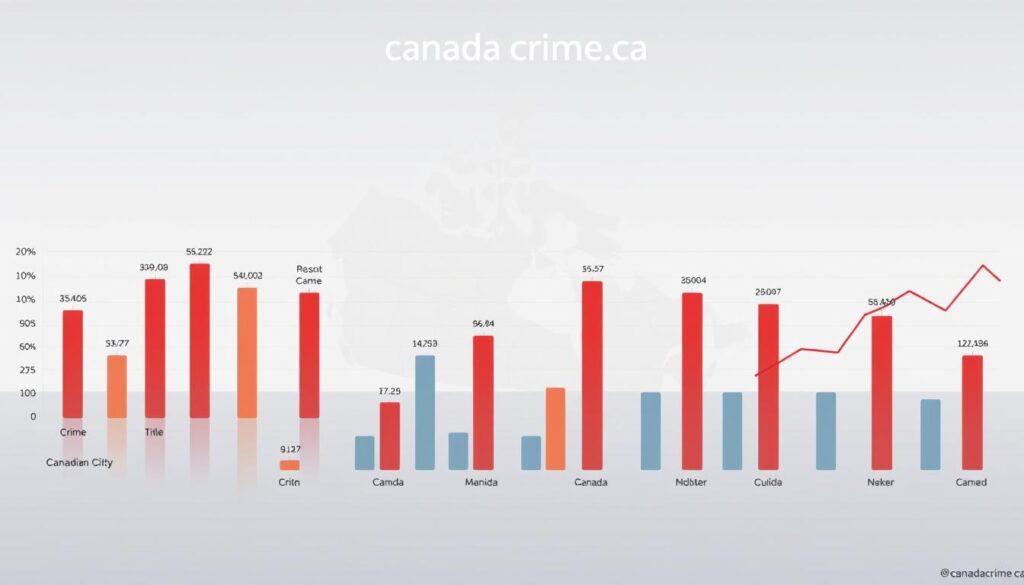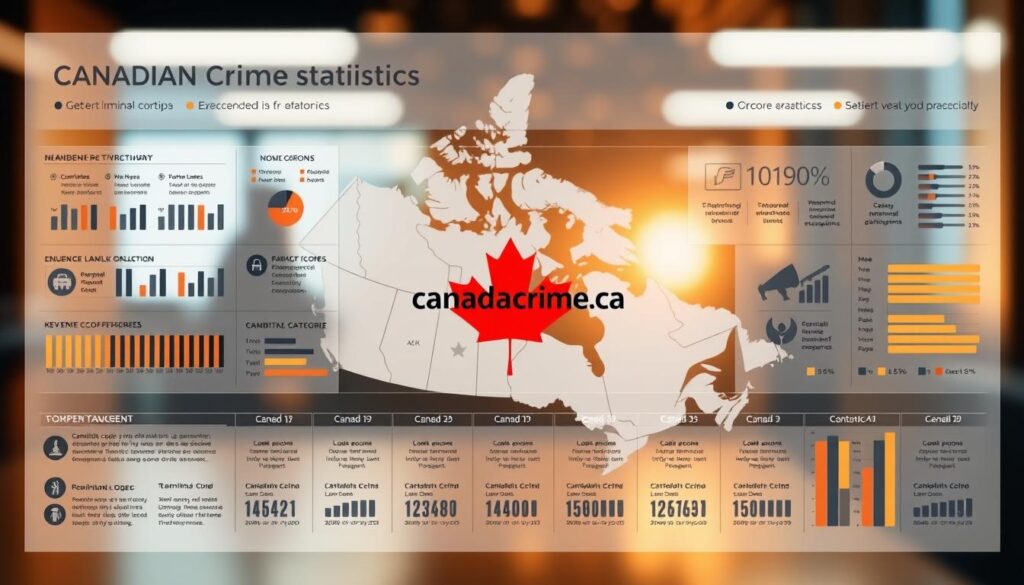Canada’s cities exhibit a stark contrast in crime rates, with some urban centers experiencing significantly higher levels of criminal activity than others. For instance, cities like North Battleford and Thompson have some of the highest Crime Severity Index (CSI) values, at 598.5 and 580.2 respectively, while cities like Quebec City and Oakville have much lower CSI values, at 22.2 and 26.1 respectively.
This disparity highlights the importance of examining crime data to understand the nuances of criminal activity across different regions. By analyzing crime statistics, individuals and policymakers can develop targeted strategies to address specific regional challenges and improve public safety.
Understanding Crime Measurement in Canada
To comprehend the crime landscape in Canada, it’s essential to understand how crime data is measured and reported. The country employs a sophisticated system to track and analyze crime statistics, providing a comprehensive view of the criminal justice landscape.
Crime Severity Index Explained
The Crime Severity Index (CSI) is Canada’s primary tool for measuring crime severity. It weights offenses based on court sentences to reflect the relative seriousness of different crimes. As noted, “The CSI provides a more nuanced view of crime than simple crime rates, as it accounts for both the volume and seriousness of offenses, giving more weight to violent or severe crimes.” This approach allows for a more accurate comparison of crime rates across different regions.

How Statistics Canada Reports Crime Data
Statistics Canada plays a crucial role in collecting and standardizing crime data from police services across the country. By ensuring consistent reporting methodologies, Statistics Canada enables meaningful comparisons between different jurisdictions. For a detailed analysis of crime rates across Canada, visiting the Canada Crime page can provide valuable insights.
Difference Between “Most Serious Offence” and “All Violations” Methods
Understanding the difference between “most serious offence” and “all violations” reporting methods is crucial when interpreting Canadian crime statistics. The Vancouver Police Department notes,
“Some statistics are reported using the ‘most serious offence method’ and others use the ‘all violations method.’ It is important to note these differences when comparing crime statistics, as the two methods are not cross-comparable.”
This distinction is vital for accurate analysis and comparison of crime data across different regions.
Crime data in Canada undergoes rigorous quality control processes, with reports typically being two to three months behind the current date to ensure accuracy and proper classification of offenses. Changes to the Criminal Code of Canada can also impact how crimes are classified and reported, creating challenges when comparing statistics across different time periods.
Compare Crime Statistics by City: Major Metropolitan Areas
Major metropolitan areas in Canada exhibit significant variations in crime severity. This disparity is evident when comparing the Crime Severity Index (CSI) across different cities.
The CSI is a crucial metric that helps understand the relative severity of crime in various urban centers. It takes into account both the volume and severity of crimes reported to the police.
Toronto vs. Vancouver vs. Montreal
Toronto, Vancouver, and Montreal, three of Canada’s largest cities, show distinct crime profiles. Toronto recorded a CSI of 69.2, representing an 11.3% increase. Vancouver’s CSI stood at 97.0, with a 5.6% increase, while Montreal’s CSI was 80.0, marking a modest 0.9% rise.
These variations highlight the complex factors influencing crime rates, including socioeconomic conditions and regional characteristics.
Edmonton and Winnipeg: Higher Crime Rate Cities
Western Canadian cities tend to experience higher crime rates. Edmonton and Winnipeg had CSI values of 113.3 and 135.8, respectively. Winnipeg’s CSI was notable for a 5.9% decrease, contrasting with the increases seen in other major cities.
Ottawa and Quebec City: Lower Crime Rate Urban Centers
In contrast, Ottawa and Quebec City stood out as major urban centers with relatively low crime severity indices. Ottawa’s CSI was 55.8, with a 3.1% increase, while Quebec City’s CSI was 61.8, marking a significant 14.2% rise.

| City | CSI | Percentage Change |
|---|---|---|
| Toronto | 69.2 | +11.3% |
| Vancouver | 97.0 | +5.6% |
| Montreal | 80.0 | +0.9% |
| Edmonton | 113.3 | +0.6% |
| Winnipeg | 135.8 | -5.9% |
| Ottawa | 55.8 | +3.1% |
| Quebec City | 61.8 | +14.2% |
The data highlights the diverse crime landscape across Canadian metropolitan areas, emphasizing the need to consider both overall CSI and specific crime categories when comparing cities.
Violent Crime Statistics Across Canadian Cities
A closer look at violent crime statistics across Canada reveals that northern communities are disproportionately affected by high crime severity indices. Violent crime is a significant concern for public safety, and understanding its prevalence in different cities is crucial for developing effective prevention strategies.
Northern Communities Leading Violent Crime Rates
Northern Canadian communities consistently report the highest violent crime rates in the country. Cities such as Thompson, Manitoba, and Prince Albert, Saskatchewan, are among those with the highest violent Crime Severity Index (CSI) scores.
- Thompson, Manitoba, recorded a violent CSI of 1,062.2, more than ten times the national average.
- Prince Albert, Saskatchewan, and North Battleford, Saskatchewan, follow with exceptionally high violent crime severity indices, highlighting significant public safety challenges.
Thompson (1,062.2) and Prince Albert (496.3): Highest Violent CSI
The violent CSI scores in Thompson and Prince Albert are alarmingly high. Thompson’s violent CSI is particularly concerning, indicating a need for targeted interventions to address the root causes of violent crime.

Year-over-Year Trends in Violent Crime (2022-2023)
Analyzing year-over-year trends in violent crime from 2022 to 2023 reveals concerning increases in some areas. For instance, the Abitibi-Ouest Region saw a 59.6% in violent crime, while Owen Sound experienced a dramatic 67.4% increase.
Cities with Significant Increases
- Abitibi-Ouest Region: +59.6%
- Owen Sound: +67.4%
Cities with Notable Decreases
Conversely, some cities achieved significant reductions in violent crime. Duncan saw a 46.3% decrease, Summerland experienced a 70.0% decrease, and Wetaskiwin recorded a 27.8% decrease.
- Duncan: -46.3%
- Summerland: -70.0%
- Wetaskiwin: -27.8%
Understanding these trends is crucial for developing targeted prevention strategies and allocating resources effectively to combat violent crime across Canada.
Property Crime Comparison by Region
Canada’s property crime landscape is characterized by stark regional differences, with certain areas experiencing much higher rates than others. This variation underscores the complexity of crime patterns across the country.
Western Canada’s Property Crime Challenges
Western Canada, particularly British Columbia, faces significant property crime challenges. Cities in this region report some of the highest property crime severity indices in the country.
British Columbia Cities Dominating Property Crime Statistics
British Columbia cities such as Duncan, Prince George, Kamloops, and Victoria have notably high property crime rates. Duncan’s property crime severity index (CSI) reached 571.7, marking a significant increase of 127.5%. Other cities like Prince George (226.8), Kamloops (187.6), and Victoria (182.5) also reported property crime severity indices above the national average.
Alberta’s Property Crime Patterns
Alberta exhibits varied property crime patterns. While cities like Edmonton (105.7) and Calgary (69.1) have moderate property crime rates, smaller communities such as Cold Lake (258.5) and Bonnyville (389.7) face more severe challenges.

Ontario and Quebec: Lower Property Crime Rates
In contrast to Western Canada, Ontario and Quebec generally enjoy lower property crime rates. Major cities in these provinces, including Toronto (59.1), Montreal (67.1), Ottawa (52.0), and Quebec City (50.8), report property CSI values well below the national average.
Atlantic Canada Property Crime Overview
Atlantic Canada presents a mixed picture regarding property crime. While some communities like Amherst (176.4) face significant challenges, others maintain relatively low rates compared to Western Canada.
| Region | City | Property Crime Severity Index (CSI) |
|---|---|---|
| British Columbia | Duncan | 571.7 |
| British Columbia | Prince George | 226.8 |
| Ontario | Toronto | 59.1 |
| Quebec | Montreal | 67.1 |
The regional differences in property crime rates highlight the need for tailored approaches to policing and crime prevention across Canada’s diverse regions.
Understanding the Canadian Criminal Code and Crime Categories
To comprehend crime statistics in Canada, it’s essential to understand the legal framework that governs crime classification. The Canadian Criminal Code provides the foundation for categorizing criminal offenses, which directly impacts how crimes are recorded and reported in official statistics.
Classification of Crimes
Crimes in Canada are categorized into indictable offenses, summary offenses, or hybrid offenses. Indictable offenses are considered more serious and carry heavier penalties, while summary offenses are less serious. Hybrid offenses can be prosecuted either way, depending on the circumstances.
The classification of crimes affects how they are weighted in the Crime Severity Index (CSI). The CSI is a statistical measure that takes into account the seriousness of crimes reported to the police.
Impact of Criminal Code Changes
Changes to the Criminal Code can significantly impact crime statistics. As the Code evolves, what constitutes a specific offense may change over time, creating challenges when comparing data across different time periods.
For instance, the Vancouver Police Department notes that Statistics Canada regularly updates offense codes and classification methods. This requires careful consideration when analyzing long-term crime trends or making historical comparisons.

Reporting Differences Across Jurisdictions
Different police jurisdictions across Canada may have varying reporting practices and priorities. Despite national standardization efforts, this can lead to potential inconsistencies in how crimes are classified and recorded.
Understanding these methodological nuances is essential for researchers, policymakers, and the public when interpreting crime statistics and making evidence-based decisions about public safety initiatives.
Crime Prevention Resources and Strategies Across Canadian Cities
The fight against crime in Canada is being waged through a combination of municipal programs, community-based initiatives, and data-driven approaches. Canadian cities are recognizing the importance of tailored strategies to address their unique crime challenges.
Municipal Crime Prevention Programs
Canadian municipalities implement various crime prevention programs tailored to their specific challenges. Many larger cities develop comprehensive strategies based on their unique crime patterns. For instance, cities with higher crime rates may focus on intensive community policing and youth engagement programs.
Community-Based Initiatives
Community-based initiatives play a crucial role in crime prevention across Canada. Neighborhood watch programs, youth engagement activities, and community policing efforts have shown success in many jurisdictions. These initiatives foster a collaborative environment between law enforcement and the community, enhancing trust and cooperation.

Using Crime Statistics to Enhance Personal Safety
Modern crime prevention increasingly relies on data-driven approaches. Many Canadian police services offer public access to crime statistics and mapping tools that help citizens understand local safety concerns. By analyzing these data, individuals can make informed decisions about personal safety measures and property protection.
Neighborhood Crime Maps and Tools
Tools like Vancouver’s GeoDASH system exemplify how technology can enhance public safety. GeoDASH provides interactive crime maps, statistical breakdowns, and open data resources for researchers and community organizations. Such tools enable citizens to visualize crime trends in their neighborhoods.
Understanding Local Crime Trends
Understanding local crime trends through publicly available statistics can help individuals make informed decisions about their safety and property. Effective crime prevention requires collaboration between law enforcement agencies, municipal governments, community organizations, and individual citizens.
- Canadian municipalities are implementing crime prevention programs tailored to their challenges.
- Community-based initiatives are crucial in crime prevention across Canada.
- Data-driven approaches are increasingly used in modern crime prevention.
Conclusion: Making Sense of Canadian Crime Statistics
A review of crime statistics across Canada’s urban centers highlights significant regional disparities in crime rates. Canadian cities show a wide variation in Crime Severity Index values, ranging from as low as 21.5 in Warman, SK, to as high as 797.5 in La Ronge, SK.
Regional Variations in Crime Rates
Canadian crime statistics reveal significant regional variations, with northern and western communities generally facing higher crime rates than central and eastern regions. For instance, cities like Thompson and Prince Albert have notably higher violent crime rates compared to other major urban centers.
Understanding these variations is crucial for policymakers, law enforcement agencies, and community organizations to develop targeted strategies for crime prevention. By examining both the Crime Severity Index and the breakdown between violent and property crimes, a more comprehensive understanding of public safety challenges can be achieved.
The data indicates that Canada’s largest cities generally maintain moderate crime rates by global standards. Cities like Quebec City, Ottawa, and Montreal rank among the safest major urban centers worldwide, with Quebec City having a Crime Severity Index of 22.2, Ottawa at 31.3, and Montreal at 32.8.
For citizens, this comparative crime data can inform decisions about personal safety, property protection, and community engagement. As Canada continues to grow and evolve, ongoing monitoring of crime statistics by city will remain essential for understanding changing patterns of criminal activity and evaluating the effectiveness of prevention and enforcement strategies.
In conclusion, while some Canadian cities have experienced increases in certain crime categories, many communities have successfully implemented strategies leading to decreases in criminal activity. By continuing to analyze and act upon crime statistics, Canada can maintain its reputation for having safe and secure urban environments.

